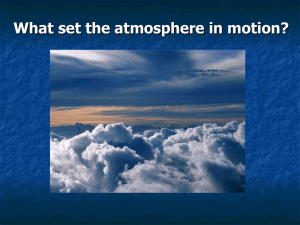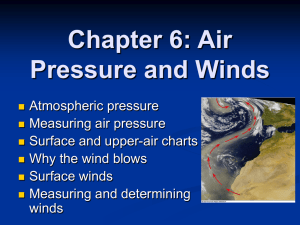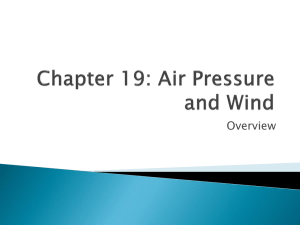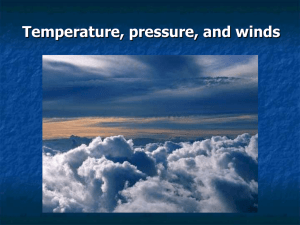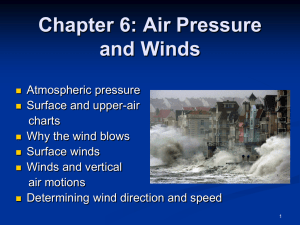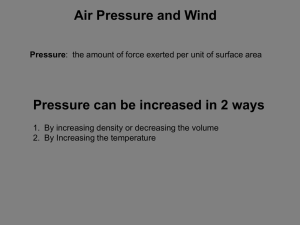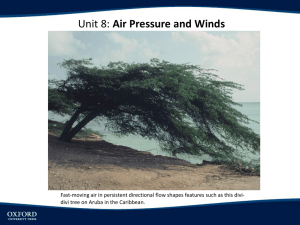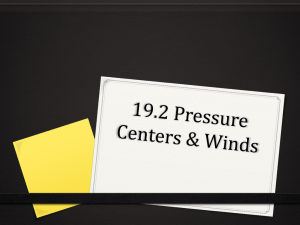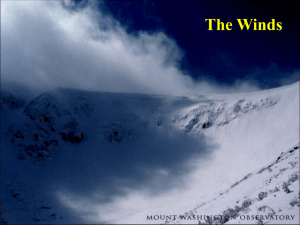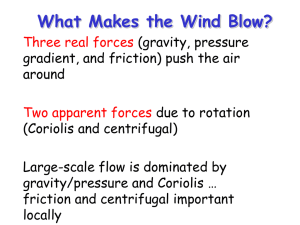Measuring Pressure
advertisement
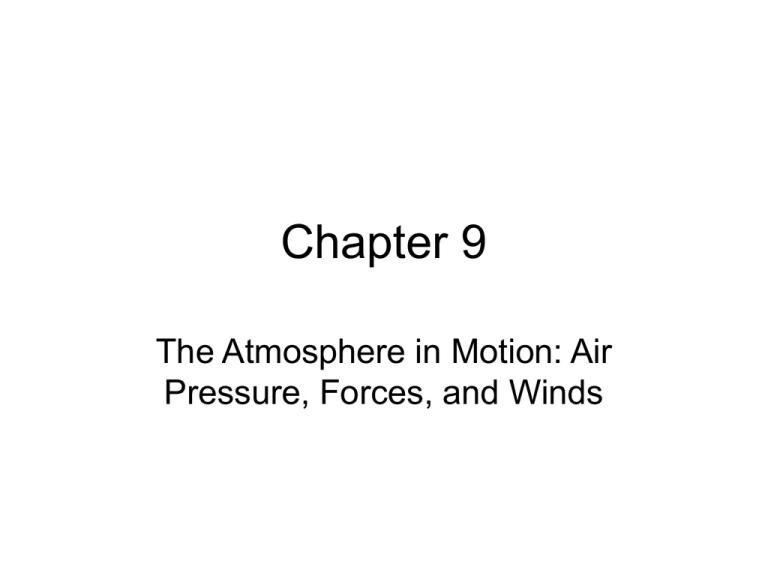
Chapter 9 The Atmosphere in Motion: Air Pressure, Forces, and Winds Atmospheric Pressure • Horizontal changes in atmospheric pressure generate wind • Remember that the vertical variation of pressure is actually much larger than the horizontal variation..... – In the horizontal direction, pressure can change by about 10 mb in a distance of 100's of kilometers Pressure Fluctuations Solar heating of ozone gasses in the upper atmosphere, and of water vapor in the lower atmosphere, can trigger oscillating thermal tides of sea-level pressure change. Pressure Scale & Units Many scales are used to record atmospheric pressure, including inches of mercury (Hg) and millibars (mb). Figure 9.4 Pressure Defined • Before we can understand how winds are created, we need to discuss the concept of pressure in greater detail... – Recall that pressure is defined as the force exerted over some area P=F/a – The atmospheric pressure can be thought of as the weight of the air above you pushing down on some area Ideal Gas Law • How can pressure change? • Air can approximately be regarded as an "ideal gas" • ideal gases obey the "ideal gas law": – P = CρT • • • • P = pressure exerted by the gas C = constant ρ = density of the gas = mass/volume T = Temperature of the gas – Or…. P = ρT (pressure increases if either the density or the temperature increases) Pressure changes due to density variations • From the ideal gas law: P = CρT – If T is constant, then P can increase by increasing the density of the gas – Conversely, if the density decreases, so does the pressure • What happens if the temperature of the air column changes? Pressure changes due to temperature variations • Take a cold column of air and warm it up: – Which column of air has a larger density? – Which column of air occupies a larger volume? – Which will be larger, the surface pressure for the cold-air column or the surface pressure for the warm air column? Pressure changes aloft due to temperature variations • Remembering that pressure is a function of how much atmosphere is above a surface: – At which location (1 or 2) will the pressure be higher? – As a result, at 5 km will air move from the cold to warm column or from the warm to cold column? Pressure changes aloft due to temperature variations • What will happen here at 500mb? – Air will move from the warm column to the colder column at 500 mb due to the pressure gradient force....., more on this later. • Measuring Pressure Pressure is usually measured with a barometer ("bar" o "meter" - an instrument that measures "bars") • 1 atmosphere (14.7 lb/in²) is the amount of pressure that can lift water approximately 33.9 feet (10.3 m). – Shallow pumps…. • Recall the different units of pressure: – 1 bar = 1000 mb – At sea level, 1013.25 mb = 29.92 inches of Hg = 76 cm of Hg • Discuss the different types of barometers.... – Mercury barometer Measuring Pressure - Aneroid Barometer • Other types of barometers.... – Aneroid barometer -->> • Most common type of barometer for home use • The aneroid cell volume is very sensitive to changes in atmospheric pressure: • The cell volume gets smaller as the atmospheric pressure increases Measuring Pressure - Altimeters and Barographs • Altimeter: – Measure pressure (aneroid barometer) but indicate altitude – Used in aircraft, hand-held for tactical navigation • Barograph Measuring Pressure at the surface - the surface pressure chart • Surface pressure chart - isobars (lines of constant pressure) are plotted every 4 mb • Maps of surface pressure are very important: – Give positions of highs and lows – Can give information about the direction and strength of the surface winds • Now will look at how a surface (sfc) pressure chart is created from observations around the country • Station elevation will dramatically affect the sfc pressure reading Measuring Pressure at the surface elevation differences • One very important source of error when generating a surface pressure chart is that not all stations are at sea level.... – So, many of the surface pressure readings contain significant errors due to altitude • Pressure decreases with height (elevation), so we must correct this in order to produce a meaningful surface weather chart… Surface Pressure vs. Sea Level Pressure Measuring Pressure at the surface - reducing pressure to sea level • Must reduce the pressure measurements to sea level using the following rule: – In the lower part of the atmosphere, pressure changes by about 10 mb for every 100 meters of elevation change.... – Using this rule, we reduce all pressure measurements to sea level, producing a constant elevation sea-level pressure (SLP) chart ..., commonly referred to as a surface weather map • Now we will look at how pressure is represented above the surface… Representing pressure above the surface • First, the tropopause height varies with latitude since: – Tropopause height is proportional to the mean tropospheric temperature. – Higher near the equator (warm troposphere – Lower at the poles (cold troposphere) Representing pressure above the surface - constant height chart • What would the pressure pattern on a constant height chart look like if Z = 5km?? Representing pressure above the surface - Z = 5 km • Pressure would decrease as you move northward • This type of chart is not used often in meteorology • Constant pressure charts, however, are used extensively....so we’ll examine these in greater detail..... • Isobaric (contant pressure) Charts First, recall that the tropospheric thickness is proportional to the mean tropospheric temperature: • As shown to the right--the 500mb surface will be located at higher levels to the south and at lower levels further north • Hence, on an isobaric chart (e.g., 500mb) we plot isopleths (contour lines) of the height of the pressure surface above sea level. Ridges & Troughs Upper level areas with high pressure are named ridges, and areas with low pressure are named troughs. These elongated changes in the pressure map appear as undulating waves. Isobaric Charts - Example of 500mb chart • Notice that the larger heights are towards the south where it is warmer • lower heights are found further north where it is colder..... Isobaric Charts - heights of the commonly used surfaces • The table to the right gives "approximate" altitudes of the common isobaric charts used in meteorology ”High to Low, look out below!” • Aircraft altimeter doesn’t measure distance from ground…it measures the pressure outside the aircraft – Aircraft altimeter assumes a standard pressure at an altitude • Pilot sets plane’s altimeter at takeoff from station A, then flies towards B – Altimeter tells him to fly along a constant P surface – The closer the aircraft gets to B, the closer to the ground it gets • If the aircraft was flying in bad wx in high terrain—would this be a good or a bad situation? • Plane drivers adapt by: – En-route RAPCON updates – Radio altimeter – TF/TA Isobaric Charts - Ridges and Troughs • Notice that the height lines are NOT oriented EW • In fact, you should see a wave-type pattern in the height lines with: – ridges – troughs • Is there warm or cold air aloft associated with a ridge? A trough?? • WE flow called zonal • NS (SN) flow called meridional (or high zonal) Ridges and Troughs Aloft - Highs and Lows at the Surface • Notice that ridges aloft are associated with Highs at the surface • Troughs aloft are associated with Lows at the surface • This association of ridges/troughs with Highs/Lows occurs most of the time, BUT NOT ALWAYS What creates wind? • Winds are the result of a balance of physical forces acting on the air: – Pressure gradient force – Coriolis force – Centripetal force – Friction • Let's now examine each of these forces, and their effects on winds....... Pressure Gradient Force (PGF) • Air will move from high to low pressure. • How strongly it flows depends on the differences in pressure • The pressure gradient is a measure of that pressure difference— the change in pressure over a given horizontal distance Isobar spacing and the magnitude of the pressure gradient • The magnitude of the pressure gradient can be assessed by noting the spacing of the isobars.... – If the isobars are far apart, the pressure gradient is small – If the isobars are close together, the pressure gradient is large (steep) Next--the Coriolis Force • The Coriolis Force (CF) arises due to the fact that the earth is rotating • Coriolis force=2mWVsinf – – – – m=mass V=speed W=earth’s angular rotation Sinf=sine of latitude Equation! • Coriolis force=2mWVsinf – – – – m=mass V=speed W=earth’s angular rotation Sinf=sine of latitude Properties of Coriolis Force (CF) • Acts on objects not rigidly attached to the earth • Always acts to deflect an object to the right (left) of it's direction of motion in the northern (southern) hemisphere • Magnitude is zero at the equator; maximum at the poles • Magnitude depends on the rotation rate of the earth - the magnitude would increase if the earth’s rotation rate increased – If the earth were not rotating, CF would be zero • CF is larger for things moving at faster speeds; zero if the object is not moving – CF is negligible for slow-moving objects, or for those moving over short distances • Such as, flushing of a toilet...or the movement of a snail CF • The Coriolis Force is an "apparent" force that arises solely due to the fact that the earth is rotating. Therefore, it can only change a parcel's direction, it CAN NOT affect its speed. • If a high speed train travels from LA to NY, will the coriolis force act on the train? • Does the coriolis force act on a baseball thrown from a pitcher to the catcher during a major league game? • Does the coriolis force have an affect on ocean currents? Definition of Geostrophic Flow • When the isobars are straight, parallel lines, and the only two forces acting on a parcel are the PGF and the CF, then the wind is called the geostrophic wind: • PGF and CF are equal in strength (magnitude) and opposite in direction • The geostrophic wind is always parallel to the isobars (height lines on an isobaric chart) Geostrophic wind—Upper level, straight height contours • Parcel at A moves toward lower pressure (PGF) • Once parcel starts moving, CF begins to “pull” to the right • Eventually, PGF=CF, and geostrophic wind develops. – Parallel to height lines/isobars – Strength dependent on magnitude of PGF Introduction to Gradient Wind Flow • Wind flow is geostrophic when the PGF and the CF are in balance – This occurs when the isobars (height lines) are relatively straight – What about the case when the isobars have curvature, as around highs and lows???? • When there is curvature in the flow, we must also consider the centrifugal force acting on a parcel..... The Centrifugal Force • If you attach a string to a ball and swing it in a circular manner, the force that is required to keep the ball moving in the circular path is called the centripetal force – The centripetal force is directed inward, towards the axis of rotation • As you swing the ball with the string, you feel the string tug on your hand...., this is called the centrifugal force and is equal and opposite to the centripetal force Centripetal Force=V2/r Becomes important for faster flow and smaller radius (such as hurricane or tornado). Gradient flow around highs and lows • So, the gradient wind is due to a combination of: – pressure gradient force – coriolis force – centrifugal force (pointing out) Boundary Layer Winds • Above approximately 850 mb (5000’), the wind flow is either in geostrophic or gradient wind balance • From the surface up to about 3500’ above ground level (AGL), we must include the effect of friction – Oops….the flow is no longer in geostrophic or gradient wind balance! • Winds near the surface of the earth Below the boundary layer (about 3500 feet AGL), friction “drags” and slows wind speed – The friction force is in the opposite direction as the wind direction • Dominant forces involved: PGF+CF+Friction • Causes wind to blow across isobars toward lower pressure • 10-40o shift from geostrophic wind – 10o over open water; up to 40o over mountainous terrain • Notice winds crossing isobars, flowing towards lower pressure • Notice strength of winds in comparison with isobar density Effect of friction on flow around lows and highs • How does friction affect flow around lows and highs near the surface? • Due to the frictional turning of the wind such that it crosses the isobars, what can you infer about the vertical motions in the vicinity of a: – surface low? – surface high? Effect of friction on flow around lows and highs - associated weather • At the center of a surface low, the air converges, and then must rise – We expect to see clouds and precip near a surface low • At the center of a surface high, the air is diverging, and must be coming from aloft due to sinking motion – We expect to see clear, dry weather near a surface high Pressure Systems • • High: center of pressure surrounded on all sides by lower pressure Air moves clockwise (anticyclonically) around the center (in the Northern Hemisphere) – – – • • Also called an anticyclone Area of sinking air Often suppresses clouds and precipitation Low: center of pressure surrounded on all sides by higher pressure Air moves counterclockwise (cyclonically) around the center – – – Also called a cyclone Area of rising air Often produces cloudy skies and precipitation Buoys-Balot Law • Upper level winds: – Stand with the upper level winds to your back • (Note cloud drift) – Upper level Low will be at “your 9 o’clock” Surface Winds • Stand with surface winds blowing at your back – Turn 30o clockwise – Surface Low pressure center will be at your “9 o’clock” Figure 9.32b Measuring winds • Two common types of instruments used to measure winds are: – Aerovanes – Anemometers – Others?? Windsock Weathervanes Wind Direction • The speed of the wind is given by the number of barbs on the wind flag (also see appendix A-5) • Wind direction is reported : – 0° - from the north (northerly) – 90° - from the east (easterly) – 180° - from the south (southerly) – 270° - from the west (westerly) Test yer learnin’ • 1. If the earth were not rotating, how would the wind blow with respect to centers of high and low pressure? • 2. Why are surface winds that blow over the ocean closer to being geostrophic than those that blow over the land? • 3. If you live in the Northern Hemisphere and a region of surface low pressure is directly west of you, what would probably be the surface wind direction at your home? If an upper-level low is also directly west of your location, describe the probable wind direction aloft and the direction in which middle-type clouds would move. How would the wind direction and speed change from the surface to where the middle clouds are located? • 4. Consider wind blowing over a land surface that crosses a coastline and then blows over a lake. How will the wind speed and direction change as it moves from the land surface to the lake surface? • 5. With your present outside surface wind, determine where regions of surface high- and low- pressure areas are located. If clouds are moving overhead, locate the locations of high- and low- pressure aloft. Key Concepts and Facts • Pressure decreases most rapidly w/ elevation in cold column of air • Cold air aloft is normally associated w/ low pressure, while warm air is associated w/ high pressure • We use a barometer to measure air pressure • The amount of pressure change that occurs over a given horizontal distance is the pressure gradient • Horizontal differences in pressure create a pressure gradient force (PGF). This force causes winds to blow • On a weather map, closely spaced isobars (or height contours) represent a steep (large) PGF and strong winds, and visa versa Key Concepts and Facts con’t • The Coriolis Force (CF) causes the wind to bend to the right of its path in the Northern Hemisphere, and to the left in the Southern Hemisphere • The CF only influences the direction of the wind and not its speed • The winds on an upper-level weather chart tend to blow parallel to contour lines in a more or less WE direction in both hemispheres (mid and high latitudes) • Sinking air (subsidence) occurs above a surface high pressure system; rising air occurs above a surface high pressure system • Surface winds tend to cross isobars, towards lower pressure, at an angle that averages 30o. • In the Northern hemisphere, surface winds blow clockwise and outward from the center of the High, and counterclockwise and inward toward the center of the Low. Opposite directions in the Southern Hemisphere.
